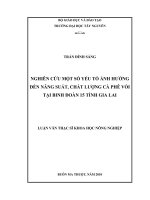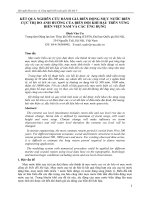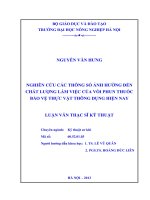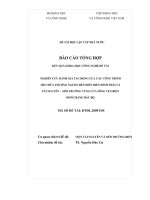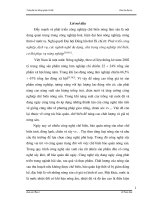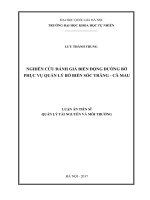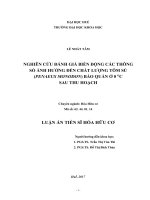nghiên cứu đánh giá biến động các thông số ảnh hưởng đến chất lượng tôm sú penaeus monodon bảo quản ở 0 oc sau thu hoạch
Bạn đang xem bản rút gọn của tài liệu. Xem và tải ngay bản đầy đủ của tài liệu tại đây (679.82 KB, 26 trang )
<span class='text_page_counter'>(1)</span><div class='page_container' data-page=1>
1
<b> HUE UNIVERSITY </b>
UNIVERSITY OF SCIENCE
<b> LE NHAT TAM </b>
<b>INVESTIGATE THE VARIATION OF THE </b>
<b>FACTORS INFLUENCING THE POST-HARVEST </b>
<b>QUALITY OF BLACK TIGER SHRIMP DURING </b>
<b>STORAGE AT 0 </b>
<b>O</b><b>C </b>
<b>Summary of PhD Dissertation </b>
</div>
<span class='text_page_counter'>(2)</span><div class='page_container' data-page=2>
2
<b>HUE UNIVERSITY </b>
UNIVERSITY OF SCIENCE
<b> </b>
<b>LE NHAT TAM </b>
INVESTIGATE THE VARIATION OF THE FACTORS
INFLUENCING THE POST-HARVEST QUALITY OF
BLACK TIGER SHRIMP DURING STORAGE AT 0
O<sub>C </sub>
<b> Major : Organic chemistry </b>
<b> Code: 62. 44. 01. 14 </b>
<b>PhD DISSERTATION </b>
<b> </b>
<b> Supervisors: </b>
<b>1. Associate professor. Tran Thi Van Thi </b>
<b>2. Associate professor. Do Thi Bich Thuy </b>
</div>
<span class='text_page_counter'>(3)</span><div class='page_container' data-page=3>
1
INTRODUCTION
Aquatic products are important sources of nutrients containing high
levels of amino acids, peptides, proteins and other essential nutrients for
daily meals. The decomposition of aquatic species occurs during
preservation by microbial activity and chemical reactions.
The method used to evaluate the quality of aquatic products depends
on their characteristics, and the preservation conditions. Each method
only assessed one stage of change, or one aspect of the preservation
process. Thus, a combination of different methods is very neccessary to
evaluate all changes of aquatic products during storage giving more
accurate, and reliable results.
Therefore, we carried out the research entitled "<b>Investigate the </b>
<b>variation of the factors influencing the post-harvest quality of black </b>
<b>tiger shrimp during storage at 0 o<sub>C " </sub></b>
In this work, we conducted a study to find out the correlation among
sensory, chemical and microbial changes during preservation of shrimp
<i>(Penaeus monodon). Basing on the obtained results, the method using to </i>
classify the quality of tiger shrimp is suggested
2. Research objectives
3. Material
<i>Black tiger shrimp (Penaeus monodon), phylum: Arthropoda, </i>
subphylum: Crustacea, order: Decapoda, family: Penaeidae, genus:
<i>Penaeus, species: Penaeus monodon. </i>
4. Methodology
</div>
<span class='text_page_counter'>(4)</span><div class='page_container' data-page=4>
2
total aerobic microorganism (TVC), and QIM
- Quantitative methods of chemical indices: TVB-N, TMA-N,
histamine, hypoxanthine and pH values.
- Statistical analysis: using Statgraphics centurion XVI software, linear
model by MS. Excel (2010).
5. New scientific results
The results indicated some important findings as follows:
+ It is a very first time that histamine and hypoxanthine indices were
used to evaluate the shrimp quality.
+ Changes in the sensory and chemical qualities of black tiger shrimp
were observed during storage at 0 o<sub>C. </sub>
+ The linear regression models between QI score, TVB-N, TMA-N,
histamine or hypoanthine with storage time were found.
+ The combination of sensory evaluation and chemical methods could
be appled to classify shrimp quality.
6. Conclusion
The results of this work provided primary infomation in evaluating the
<b>quality of aquatic products after harvest. </b>
CHAPTER 1. LITERATURE REVIEW
1.1 Introduction
Characteristics of black tiger shrimp
Chemical composition of some shrimp species
1.2 Type of spoilage and sensory changes during storage: spoilage is
caused by microorganisms, enzymes or chemical reactions.
1.3 Quality assessing method: sensory evaluation, chemistry, physics,
and microbiology measurement.
</div>
<span class='text_page_counter'>(5)</span><div class='page_container' data-page=5>
3
1.5 Quantitative method: high performance liquid chromatography
(HPLC); ultraviolet-spectral method
1.6 Some models of quality assessment are based on a combination of
different methods
Chapter 2. RESEARCH OBJECTIVES AND METHODS
2.1. Research objectives
- Investigating the correlation between sensory, chemical, and
<i>microbiological changes of tiger shrimp preservation (Penaeus </i>
<i>monodon) during storage at 0 ° C basing on quality indices. </i>
- Developing the quality classification scale of tiger shrimp basing on
quality indices.
2.2. Research content
The research content of the study consisted 5 parts:
- Developing method for assessing the quality of shrimp (Penaeus
monodon) by QIM.
- Developing quantitative method of hypoxanthine on shrimp by HPLC.
- Developing linear regression equations between TVB-N, TMA-N,
histamine and hypoxanthine.
- Investigating the sensory and chemical changes of black tiger shrimp
during storage at 0oC and the correlation between sensory quality and
chemical quality.
- Developing the quality classification scale basing on sensory and
chemical indices.
2.3. MATERIALS, CHEMICALS AND EQUIPMENTS
2.3.1.Materials
</div>
<span class='text_page_counter'>(6)</span><div class='page_container' data-page=6>
4
Fig 2.1 Experimental design
2.3.2. Chemicals and equipments
The chemicals used in this research were good quality.
2.4. MEASUREMENT
2.4.1 Determining TVC method (Leboffe et al.) [140].
2.4.2. QIM method
2.4.2.1. Sample preparation (according to 2.3.1)
2.4.2.2. Selecting and training the panel
The panel was selected and trained carefully for the sensory evaluation
[226].
Steps for organizing the panel:
Step 1: Primary recruitment for the panel
Fig. A schematic overview of the experimental study. QIM refers to quality index method;
TVB-N refers to total volatile basic nitrogen; TMA-TVB-N refers to trimethylamine nitrogen; His refers to
histamine; Hx refers to hypoxanthine, TVC refer to total visible counts
Shrimp was stored at 0
0
C
QIM
n =3
Farm 1 Farm 2 Farm 3
TVB-N
n = 3
Shrimp harvested from farm (10 kg per farm)
Washed using filtered clean flowing water
Packaged in polyethylene bags
TMA-N
n = 3
Stored in ice in polyethylene boxes
Transported to the laboratory
His
n = 3
Hx
n = 3
Analysis
</div>
<span class='text_page_counter'>(7)</span><div class='page_container' data-page=7>
5
Step 2: Recruiting according to the requirement
Step 3: Training the testers
Step 4: Final recruitment the testers for official assessment
- Primary recruitment for the panel [110]
20 people participated in the recruitment, and selecting 12 members for
the panel.
-Training the testers (TCVN 11045: 2015) [239].
During this process, 12 members attended the training sessions and
recruitment. During this period, six members were considered for the
official panel Selectng testers in the official sensory evaluation
-Selecting testers for the official panel (TCVN 11045: 2015)
Six testers having the ability, health and time for the sensory evaluation
process were selected.: Guidance on sensory evaluation in laboratory for
fish and shellfish [5].
2.4.2.3. Assessing quality
Assessing quality of shrimp according to QIM includes the following
steps:
+ Describing the attributes of black tiger shrimp
+ Developing QIM
+ Applying QIM to determine the QI for each piece of shrimp every day
during storage
+ Assessment QIM method
</div>
<span class='text_page_counter'>(8)</span><div class='page_container' data-page=8>
6
Sample preparation was conducted according to 2.3.1 section
2.5.2. TVB-N
The concentration of TVB-N was determined according to TCVN 9215:
2012 [7].
2.5.3. TMA-N
The TMA concentration was measured according to AOAC 971-14 [8].
2.5.4. Histamine
Histamine was determined by the HPLC accoding to the earlier report of
Gouygou et al. (1987).
2.5.5. Hypoxanthine
Hypoxanthine in shrimp was extracted as described by Ryder (1985)
[217] and was measured according to Kock et al. [127] and Nacalai's
method [267]
2.5.6. pH
The pH value was performed according to the report of Özogul et al.
[193].
2.6. EXPERIMENTAL DESIGN
2.6.1. Determining aerobic microorganisms
Experiment 1: Investigating the amount of TVC in black tiger shrimp
during storage
2.6.2. Developing QIM and evaluating quality of shrimp according QIM
Experiment 2: Developing desriptors
Experiment3: Verificating desriptors by Cata method
Experiment 4: Evaluating shrimp quality every day during storage days,
establishing the correlation between QI and storage time.
</div>
<span class='text_page_counter'>(9)</span><div class='page_container' data-page=9>
7
2.6.3. Investigating the change of chemical indices during storage
2.6.3.1. Sample preparation
2.6.3.2. Measuring the changes in quality indices
Experiment 6: Selecting the method to determine the hypoxanthine
content of black tiger shrimp
Experiment 7: Developing the standard curve, recovery efficiency,
LOD, LOQ and RSD values
Experiment 8: Evaluating the TVB-N content in black tiger shrimp
samples during storage
Experiment 9: Evaluating the TMA-N content in black tiger shrimp
samples during storage
Experiment 10: Evaluating the histamine content in black tiger shrimp
during storage
Experiment 11: Evaluating the hypoxanthine content in black tiger
shrimp during storage.
Experiment 12: Determining the pH value of black tiger shrimp during
storage.
2.7. Statistical analysis
All experiments were carried out 3 times. All data were processed by
Statgraphics centurion XVI software (P<0.05), MS. Excel (2010).
CHAPTER 3. RESULTS AND DISCUSSION
3.1 Results of TVC in shrimp during storage.
</div>
<span class='text_page_counter'>(10)</span><div class='page_container' data-page=10>
8
10 was 5,84; 6,39; 6,37, respectively. As a result, the number of TVC
increased rapidly from the 8th<sub> of storage. </sub>
Fig 3.1 The changes of TVC in shrimp during 10 days of storage at 0°C
According to International Commission on Microbiological
Specifications for Foods (ICMSF), the maximum log cfu / g of frozen
shrimp was 6. This is also in agreement with the regulation of Health
Ministry (No. 46/2007 / QD-BYT, 19 December 2007). Thus, tiger
shrimp stored at 0 ° C had a shelf life up to 8 days basing on
microorganism aspect.
3.2. Developing QIM and evaluating shrimp quality according to QIM
3.2.1. QIM model for quality evaluating of black tiger shrimp.
The QIM (Table 3.1) was developed during training panel basing on
TCVN 3726-89 [2] and previous reports [4], [22], [91], [291].
<b>Table 3.1 QIM for black tiger shrimp </b>
<b>Attribute</b>
<b>s </b> <b>Descriptors </b>
<b>Scor</b>
<b>e </b>
Color Head
Light pink, no black spot 0
Light blue, no black spot 1
Light blue turns to light black 2
Big black mark 3
0
2
4
6
8
1 2 3 4 5 6 7 8 9 10
<b>TVC </b>
<b>(logcfu/g)</b>
</div>
<span class='text_page_counter'>(11)</span><div class='page_container' data-page=11>
9
Body
Blue, no black spots, shiny 0
Grey blue, slightly yellow, no black
spot 1
Reddish brown, black spots 2
Black body 3
Tail
Light pink, no black spot 0
Light blue 1
black spots not more than two tail at the
bottom 2
Visible turbidity at the tail 3
Flesh
Fresh, trasparent, with no black spot 0
Turning to turbidity 1
Pale, the position near the head was
light blue 2
The position near the head was light
yellow or green 3
Structure
Structu
re
Intact 0
Head was slightly loose to the body 1
Head was separated with the body 2
Head was separated with the body, soft
shell 3
Flesh
Firm, elastic 0
Less elastic 1
Soft 2
Very soft 3
Odor Odor Fresh shrimp characteristic odor 0
</div>
<span class='text_page_counter'>(12)</span><div class='page_container' data-page=12>
10
No odor, slight ammoniac odor 2
Unpleasant odor, strong ammoniac
odor 3
3.2.2 Quality changes of black tiger shrimp during storage
Fig. 3.2 presented the quality changes of shrimp during storage according
to QIM
<b>Fig. 3.2 Linear Regression model between storage time and QI of </b>
shrimp
The results indicated that QI had linear correlation with storage
days. This finding was in accordance with earlier reports (Martinsdöttir
et al., 2001) and [107], [171]. According to this obtained equation, we
can estimate the shelf life of shrimp.
3.2.3. Evaluating the accuracy of QIM
</div>
<span class='text_page_counter'>(13)</span><div class='page_container' data-page=13>
11
<b>Fig. 3.3 Testing the accuracy of QIM method according to estimated </b>
storage time and real storage time
3.2.4. Quality classification of shrimp by QI
According to Hanpong et al. [91], the evaluation scale for color, taste and
structure of black tiger shrimp stored at 0 ° C was from 1 to 9, where 1=
extremly like and 9= extremly dislike. The results showed that shrimp
preserved from 1 to 2 days was perfect quality, from 3 to 5 days was good
quality, from day 6 to day 7 was moderate quality, at day 8 was still
acceptable quality. After the 8th<sub> day, the quality of shrimp was </sub>
unacceptable. Jayaweera and Subasinghe et al. [113] found that type 1
<i>shrimp (Penaeus indicus) chilled storage had a shelf life from 1 to 3 days, </i>
type 1 shrimp had shelf life until 7 days, accepted quality till 10 days.
After 10 days, shrimp was rejected due to poor quality. Cann [38] also
reported that black tiger shrimp preserved at 0 ° C decreased the quality
of taste from 2 to 4 days and appeared black spots from 6 to 9 days. Relly
et al. [209] indicated that the quality of shrimp reduced after 2 days of
storage at 0°C.
</div>
<span class='text_page_counter'>(14)</span><div class='page_container' data-page=14>
12
protein, amine, lipid and fatty acid occurred. Therefore, the changes in
color, odor and structure were detected clearly. The spoilage symptom
appeared at the 8th<sub> day. According to the obtained results, the shelf-life of </sub>
black tiger shrimp stored at 0°C was 8 days and the quality classification
of shrimp was shown in Table 3.2.
Table 3.2 Quality classification of shrimp by QI
Classification QI
Perfect ≤ 3,27
Good 3,67 ÷ 7,47
Moderate 7,47 ÷ 11,37
Acceptable 11,37 ÷ 14,50
3.3. DEVELOPING METHOD FOR HYPOXANTHINE
DETERMINATION IN SHRIMP
3.3.1. Result selection method
Determining hypoxanthine concentration was conducted as previous
report of Kok et al. (1993).
3.3.2. Standard curve
</div>
<span class='text_page_counter'>(15)</span><div class='page_container' data-page=15>
13
Fig 3.4 Linear regression model between peak area and concentration
The results of HPLC showed the correlation between the peak area
and the concentration. The equation of standard curve was y= 126,35x +
10,285 (R2 = 0,9977).
3.3.2.1 Determine LOD and LOQ values
0.01 ppm hypoxanthine standard was used (7 times) to evaluate LOD.
The value of LOD = 3Cm / T [206], the empirical data was LOD = 3.
0.01 / 13.13 = 0.002 ppm, LOQ = 3LOD = 0.006 ppm.
3.3.2.2. Determining the relative standard deviation (RSD)
RSD values are determined on 10 standard samples with 1ppp
concentration. The RSD value was 5.32%
3.3.2.3. Recovery efficiency (H)
Experiment 7 was carried out to determine the recovery efficiency H,
and the average H = 90.10%.
3.4. QUALITY CHANGES OF SHRIMP BASING ON QUALITY
INDICES
3.4.1. TVB-N
TVB-N concentration was measured in experiment 7. The changes of
TVB-N in shrimp during storage were shown in Fig. 3.5. The TVB-N
value consisted of TMA-N, DMA-N, NH3 and volatile amines.
y = 126.35x + 10.285
R² = 0.9977
0
100
200
300
400
500
0 0.5 1 1.5 2 2.5 3 3.5
S
</div>
<span class='text_page_counter'>(16)</span><div class='page_container' data-page=16>
14
<b>Fig. 3.5 TVB-N concentration during storage </b>
In general, the amount of TVB-N in shrimp was significant difference
among storage days. TVB-N values increased slowly from day 1 to 4
(6.47 to 11.39 mg/100g, respectively) and leveled up rapidly from day 5.
Figure 3.5 showed that the angular coefficients of two linear regression
equations representing the correlation between TVB-N content and 2
stages of storage (day 1-4 and day 5-10) were different.
3.4.2. TMA-N
TMA-N concentration was measured in experiment 8. The changes of
TMA-N in shrimp during storage were shown in Fig. 3.6.
y = 4.5243x - 8.5678
R² = 0.9907
0
10
20
30
40
50
0 5 10 15
<b>TVB-N</b>
<b>Ngày</b>
y = 1.6003x + 4.6748
R² = 0.9785
0
2
4
6
8
10
12
0 2 4 6
<b>TVB-N</b>
</div>
<span class='text_page_counter'>(17)</span><div class='page_container' data-page=17>
15
<b>Fig. 3.6 TMA-N concentration during storage </b>
The TMA-N concentration in shrimp was significant difference
among storage days (p < 0,05). The change of TMA-N had the similar
trend to TVB-N. TMA-N increased slowly from day 1 to 4 (0,66 to 1,51
mg/100 g, respectively) and leveled up rapidly from day 5. The TMA-N
content reached the maximum value at day 10 with 10,45 mg/100 g.
<b>3.4.3. Histamin </b>
Histamin concentration was measured in experiment 9. The changes of
histamin in shrimp during storage were shown in Fig. 3.7. In general,
histamine content in shrimp was significant difference among storage
days (p < 0,05).
Fig 3.7 Histamin concentration during storage
y = 0,16x + 0,31
R² = 0,994
0
0.5
1
1.5
0 2 4 6
<b>Histamine</b>
<b>Days </b>
y = 0,44x - 1,18
R² = 0,991
0
1
2
3
4
0 5 10 15
<b>Histamine</b>
<b>Days</b>
y = 0.2778x + 0.3467
R² = 0.9577
0
0.5
1
1.5
2
0 1 2 3 4 5
<b>TMA-N</b>
<b>Days</b>
y = 1.7587x - 6.9313
R² = 0.994
0
2
4
6
8
10
12
0 5 10 15
<b>TMA-N</b>
</div>
<span class='text_page_counter'>(18)</span><div class='page_container' data-page=18>
16
The histamine content in shrimp related to the metabolism of
microorganisms, the rate of formation varied from the first stage (day 1
to 4) to the second stage (day 5 to 10). In the first stage of storage, the
histamine level increased slowly (from 0.46 mg / 100 g to 0.95 mg / 100
g). In the second stage, histamine content increased rapidly from 1.13 mg
/ 100 g to 3.23 mg / 100g.
<b>3.4.4. Hypoxanthine </b>
Fig. 3.8 showed the hypoxanthine content in shrimp during storage.
<b>Fig. 3.8 Hypoxanthine concentration during storage </b>
Overall, hypoxanthine content in shrimp increased significantly
during storage (p <0.05). The linear regression equation describing the
correlation between hypoxanthine content and storage time was y = 0.25x
- 0.23 (R2<sub> = 0.976) where y: the hypoxanthine content, x: the storage time. </sub>
In comparison with the TVB-N, TMA-N, and histamine, hypoxanthine
content increased linearly and there was no difference between the two
<b>periods of storage from day 1 to 4 and day 5 to 10. </b>
<b>3.4.5. pH </b>
The pH change was shown in Fig. 3.9. The pH value on the 1st<sub> day </sub>
was 7.07 and decreased to 6.93 on the 3rd<sub> day. Then the pH started to rise </sub>
on day 4 until day 10. The reduction in pH might be due to the
decomposition of glycogen at the initial time. The increase of pH was
because of the breakdown of the protein producing biological amines.
y = 0.2487x + 0.2282
R² = 0.9709
0
1
2
3
4
0 1 2 3 4 5 6 7 8 9 10 11
Hx
</div>
<span class='text_page_counter'>(19)</span><div class='page_container' data-page=19>
17
<b>Fig. 3.9. pH value of shrimp during storage </b>
<b>3.5. Correlation equation between chemical quality indices and QI </b>
<b>sensory </b>
Table 3.3 summarized the changes in quality of black tiger shrimp
during storage. The three indices including TVB-N, TMA-N and
histamine related to bacterial counts, therefore, the concentration of
TVB-N, TMA-N and histamine was significant difference in the two
periods of storage (day 1 to day 4 and day 5 to day 10). The results
indicated that chemical quality indices linearly correlated with the
storage time. Table 3.4 presented the linear regression equations of
quality indices.
6.6
6.8
7
7.2
7.4
7.6
7.8
0 1 2 3 4 5 6 7 8 9 10 11
pH
</div>
<span class='text_page_counter'>(20)</span><div class='page_container' data-page=20>
18
<b>Storage time </b> <b>QI </b> <b>TVB-N </b>
<b>(mg/100g) </b>
<b>TMA-N </b>
<b>(mg/100g) </b>
<b>Histamine </b>
<b>(mg/100g) </b>
<b>Hypoxanthine </b>
<b>(µM/g) </b> <b>pH </b>
Day 1 <sub>1,53</sub>b <sub>± 0,06 </sub> <sub>6,47</sub>a<sub>± 0,09 </sub> <sub>0,67</sub>b <sub>± 0,02 </sub> <sub>0,46</sub>b <sub>± 0,02 </sub> <sub>0,68</sub>b <sub>± 0,03 </sub> <sub>7,07</sub>a <sub>± 0,02 </sub>
Day 2 <sub>3,67</sub>c <sub>± 0,055 </sub> <sub>7,77</sub>b <sub>± 0,08 </sub> <sub>0,89</sub>c <sub>± 0,02 </sub> <sub>0,66</sub>c <sub>± 0,03 </sub> <sub>0,78</sub>c <sub>± 0,04 </sub> <sub>6,75</sub>b <sub>± 0,03 </sub>
Day 3 <sub>5,60</sub>d <sub>± 0,10 </sub> <sub>9,09</sub>c <sub>± 0,04 </sub> <sub>1,08</sub>d <sub>± 0,02 </sub> <sub>0,79</sub>d <sub>± 0,01 </sub> <sub>0,95</sub>d <sub>± 0,04 </sub> <sub>6,93</sub>c <sub>± 0,03 </sub>
Day 4 <sub>7,47</sub>d <sub>± 0,06 </sub> <sub>11,39</sub>d <sub>± 0,07 </sub> <sub>1,51</sub>e <sub>± 0,02 </sub> <sub>0,95</sub>e <sub>± 0,02 </sub> <sub>1,02</sub>d <sub>± 0,01 </sub> <sub>7,09</sub>a <sub>± 0,01 </sub>
Day 5 <sub>9,53</sub>e <sub>± 0,06 </sub> <sub>14,57</sub>e <sub>± 0,09 </sub> <sub>2,09</sub>f <sub>± 0,03 </sub> <sub>1,13</sub>f <sub>± 0,02 </sub> <sub>1,38</sub>e <sub>± 0,02 </sub> <sub>7,20</sub>d <sub>± 0,01 </sub>
Day 6 <sub>11,37</sub>f <sub>± 0,12 </sub> <sub>18,89</sub>f <sub>± 0,10 </sub> <sub>3,34</sub>g <sub>± 0,03 </sub> <sub>1,35</sub>g <sub>± 0,01 </sub> <sub>1,59</sub>f <sub>± 0,03 </sub> <sub>7,29</sub>e <sub>± 0,03 </sub>
Day 7 <sub>12,93</sub>g <sub>± 0,12 </sub> <sub>22,73</sub>g <sub>± 0,06 </sub> <sub>5,15</sub>h<sub> ± 0,03 </sub> <sub>1,88</sub>h <sub>± 0,02 </sub> <sub>2,07</sub>g <sub>± 0,02 </sub> <sub>7,36</sub>f <sub>± 0,04 </sub>
Day 8 <sub>14,33</sub>h <sub>± 0,12 </sub> <sub>28,15</sub>h <sub>± 0,06 </sub> <sub>7,36</sub>i <sub>± 0,04 </sub> <sub>2,41</sub>i <sub>± 0,01 </sub> <sub>2,13</sub>g <sub>± 0,02 </sub> <sub>7,43</sub>g <sub>± 0,04 </sub>
Day 9 <sub>15,93</sub>i <sub>± 0,25 </sub> <sub>32,30</sub>i <sub>± 0,03 </sub> <sub>9,14</sub>k <sub>± 0,05 </sub> <sub>2,83</sub>k <sub>± 0,01 </sub> <sub>2,49</sub>h <sub>± 0.02 </sub> <sub>7,59</sub>h <sub>± 0.04 </sub>
Day 10 <sub>16,93</sub>k <sub>± 0,12 </sub> <sub>37,52</sub>k <sub>± 0,07 </sub> <sub>1,48</sub>l <sub>± 0,07 </sub> <sub>3,23</sub>l <sub>± 0,02 </sub> <sub>2,87</sub>i <sub>± 0.19 </sub> <sub>7,71</sub>i <sub>± 0.02 </sub>
Linear
regression
equation (x:
storage time)
QI = 1,72 x + 0,55
R2<sub> = 0,993 </sub>
(x: 1 10)
TVB-N = 1,60x +
4,68
R2<sub> = 0,978 </sub>
(x: 14)
TVB-N = 4,52x
+8,57
TMA-N = 0,28x + 0,35
R2 <sub>= 0,958 </sub>
(x: 1 4)
TMA-N = 1,76x +6,93
R2<sub> = 0,994 </sub>
(x: 5 10)
His = 0,16x + 0,31
R2<sub> = 0,994 </sub>
(x: 1 4)
His = 0,44x -1,18
R2<sub> = 0,991 </sub>
(x: 5 10)
Hx = 0,25x + 0,23
R2<sub> = 0,976 </sub>
(x: 1 10)
Giá trị pH khơng
tuyến tính với thời
</div>
<span class='text_page_counter'>(21)</span><div class='page_container' data-page=21>
19
Table 3.3. QI, TVB-N, TMA-N, histamine, hypoxanthine and pH during storage
<b>Table 3.4. Linear regression equation between chemical quality indices of shrimp </b>
Linear regression equation between chemical quality indices of shrimp (day 1 to 4)
<b>TMA-N </b> <b>Histamine </b> <b>Hypoxanthine </b>
TVB-N
TVB-N = 5,69(TMA-N) +
2,76
R2<sub> = 0,996 </sub>
TVB-N = 9,89His – 1,61
R2<sub> = 0,966 </sub>
TVB-N = 15,81Hx – 2,32
R2<sub> = 0,930 </sub>
TMA-N TMA-N = 1,72His – 0,19
R2<sub> = 0,947 </sub>
TMA-N = 0,33Hx + 0,35
R2<sub> = 0,894 </sub>
Histamine
His = 1,60Hx + 0,4
R2<sub> = 0,968 </sub>
<b>Linear regression equation between chemical quality indices of shrimp (day 5 to 10) </b>
TVB-N
TVB-N = 2,55(TMA-N) + 9,40
R2 <sub>= 0,980 </sub>
TVB-N = 10,12His + 3,75
R2 <sub>= 0,978 </sub>
TVB-N= 18,96Hx + 6,88
R2 <sub>= 0,978 </sub>
R2<sub> = 0,991 </sub>
</div>
<span class='text_page_counter'>(22)</span><div class='page_container' data-page=22>
20
TMA-N
TMA-N = 3,97His – 2,21
R2 <sub>= 0,998 </sub>
TMA-N = 7,30Hx – 6,16
R2 <sub>= 0,963 </sub>
Histamine
</div>
<span class='text_page_counter'>(23)</span><div class='page_container' data-page=23>
<b>3.6. The proposal model to classify the quality of black tiger shrimp </b>
<b>basing on the combination of QIM method and chemical quality </b>
<b>indices </b>
This work suggested that the classification of shrimp quality was
divided into four categories: Perfect, good, moderate and acceptable.
Table 3.5 showed the sensory evaluation scores (QI) and the values of
the chemical quality indices for each category.
<i><b>Table 3.5. Classification of shrimp (Penaeus monodon) basing on </b></i>
the combination of QIM method and chemical quality indices
<b>Classification Perfect </b> <b>Good </b> <b>Moderate </b> <b>Acceptable </b>
QI ≤ 3,67 3,67 ÷ 7,47 7,47 ÷ 11,50 11,50 ÷ 14,50
TVB-N ≤ 7,77 7,77 ÷ 11,37 11,37 ÷ 18,89 18,89 ÷ 28,15
TMA-N ≤ 0,89 0,89 ÷1,51 1,51 ÷ 3,34 3,34 ÷ 7,36
His ≤ 0,66 0,66 ÷ 0,95 0,95 ÷ 1,35 1,35 ÷ 2,41
Hx ≤ 0,78 0,78 ÷ 1,02 1,02 ÷ 1,59 1,59 ÷ 2,13
<b>CONCLUSION </b>
The results of this thesis “Evaluating the effects of factors on quality
<i><b>of shrimp (Penaeus monodon) during storage at 0°C after harvest” </b></i>
<b>indicated some important findings as follows. </b>
</div>
<span class='text_page_counter'>(24)</span><div class='page_container' data-page=24>
g, Hx = 2.13 μM / g, QI = 14.50.
3. Developing method to measure the hypoxanthine content in shrimp
during storage by HPLC.
4. R2<sub> value in the linear regression equation containing chemical </sub>
indices showed a strong correlation between TVB-N, TMA-N,
histamine and hypoxanthine in tiger shrimp preserved at 0°C. This is the
new scientific finding, the values of the indices can be found from the
regression equation.
5. The spoilage process of black tiger shrimp was divided into two
stages: autolysis (from day 1 to 4) and decomposition (from day 5 to day
10). The correlation between TVB-N, TMA- N and histamine was
described by two linear regression equations at these two stages. This is
also the new scientific finding.
6. It is the first time, two chemical indices of His and Hx were used to
assess shrimp quality and proved to be strong correlation with shrimp
quality. This point is new as well.
7. Developing the method to examine the quality of black tiger shrimp
basing on the combination of sensory evaluation and chemical indices.
This method proved to be efficient in assessing the shrimp quality. It is
new scientific result.
<b>PUBLICATIONS </b>
<b>International journal </b>
1. Le, N. T., Doan, N. K., Ba, T. N., & Tran, T. V. T. (2017). Towards
improved quality benchmarking and shelf-life evaluation of black tiger
<i>shrimp (Penaeus monodon). Food Chemistry, 235, 220-226. </i>
</div>
<span class='text_page_counter'>(25)</span><div class='page_container' data-page=25>
1. Le Nhat Tam, Tran Thi Van Thi (2015), Preliminary studies
assessing the quality balack tiger shrimp by sensory evaluation and
combined with the quantitative indicators trimethylamin, total volatile
<i>base, histamine, Journal chemistry, 53, 190-196. </i>
2. Le Nhat Tam, Doan Nhu Khue, Tran Thi Van Thi (2016),
Chemical quality indices for freshness evaluation of black tiger shrimp
<i>(Penaeus monodon), Journal science & technology, 54(2B), 162-169. </i>
3. Le Nhat Tam, Nguyen Nam Giao, Tran Thi Ngoc Nhung, Dao Bich
Duyen, Le Thi Hong Nhung, Nguyen Ba Thanh, Tran Thi Van Thi (2017),
Development of quality index method to assess freshness and shelf-life
<i>of black tiger shrimp (Penaeus monodon) stored at 0 °C, Journal science </i>
<i>& technology, Hue University, 126(1B), 19-28 </i>
4. Le Nhat Tam, Doan Nhu Khue, Tran Thi Van Thi (2017), Survey
concentration of hypoxanthine and Histamine in black tiger shrimp stored
<i>at 0 °C, Journal chemistry, 55(1), 52-57. </i>
5. Le Nhat Tam, Huynh Nguyen Que Anh, Le Tan Khanh Trinh,
Doan Nhu Khue, Tran Thi Van Thi, Đo Thi Bich Thuy (2017), The effect
of organic acids salts on the quality and shelf- life of black tiger shrimp
<i>(Penaeus monodon) in the storage at 0</i>0<i><sub>c, Journal chemistry, 55(4E23), </sub></i>
153-159.
</div>
<span class='text_page_counter'>(26)</span><div class='page_container' data-page=26>
during stored in 0 o<i><sub>c, Journal science & technology, Hue University of </sub></i>
</div>
<!--links-->
